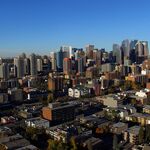Yeah the "foreign-made" paver thing and the fact people will be unsafe walking near construction fencing near homeless people is where they lost me - it's a total shotgun approach to cast doubts on the project. There's legitimate construction timing and impact concerns that can be discussed, but credibility goes out the window with references like that.
More productively, one idea that I was thinking about in these street rebuild sagas is we always try to do it all at once with utilities and surface stuff. Perhaps we either:
- Make all streetscape projects dependent on a trigger by a utility projects (e.g. sorry your drinking water pipe is broken and lives depend on it so we have no choice - we are digging up your street. As a bonus when we put back the sidewalks they will be upgraded).
- Ignore utility projects altogether (all we are doing is quickly fixing the bricks and adding nice trees, we don't need to move utilities for that and save 50% of the construction time).
Obviously #2 results in extra costs that the utility coming in later and ripping everything up again, but public perception is often how this is works anyways. It's not clear that either of these would stop the complains or result in a better public realm though!
My other thought is surely construction impacts is a universal problem the world over - how do European cities maintain they're stellar/far more busy walkable public streets with centuries of utilities, metros and infrastructure needing maintenance underneath them? Is there anything to learn about construction phasing/length that can help us out?
Or is the whole world forever condemned to have construction impacts and grumbling locals - so best to just get on with it and let people complain?





